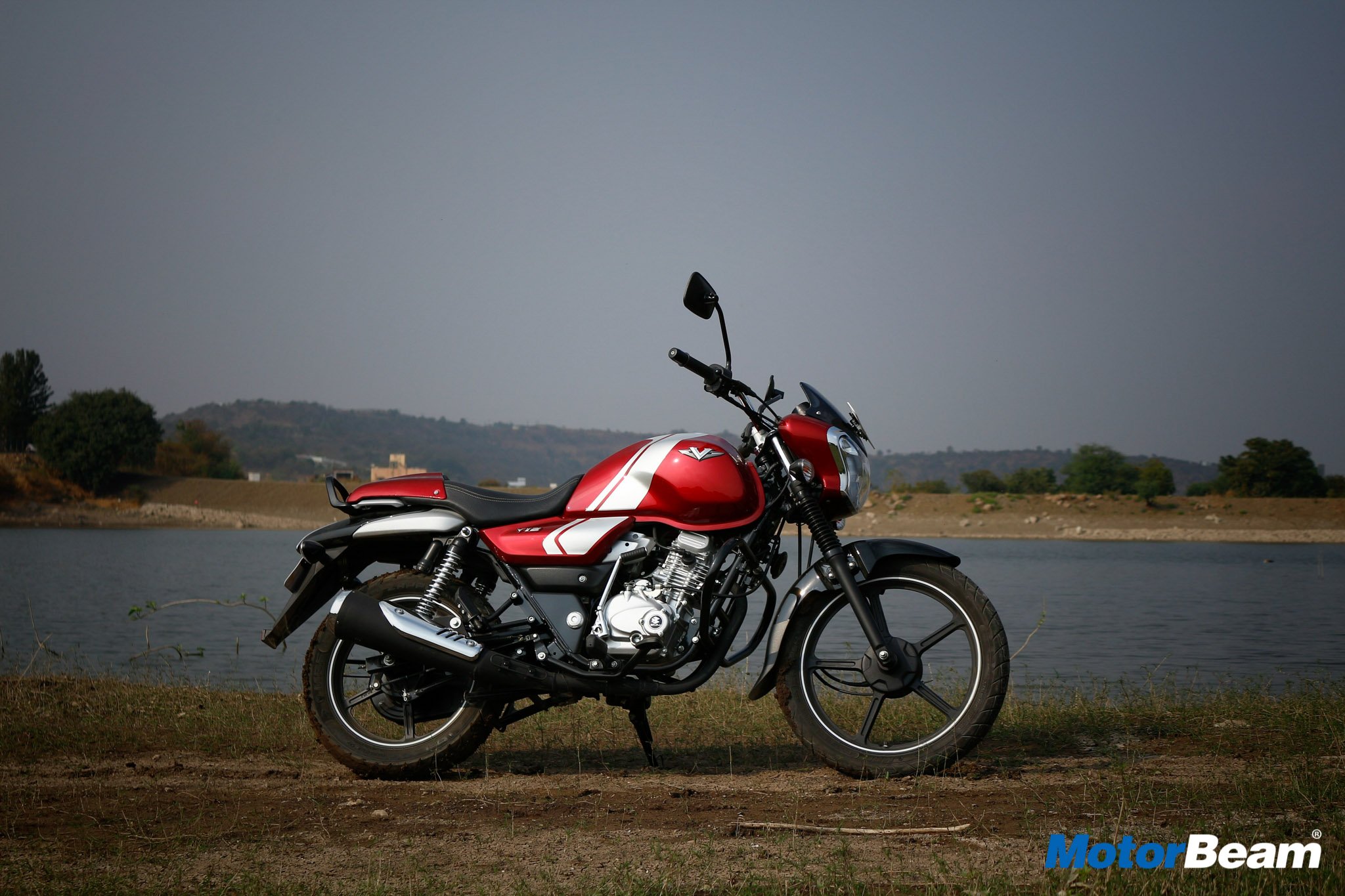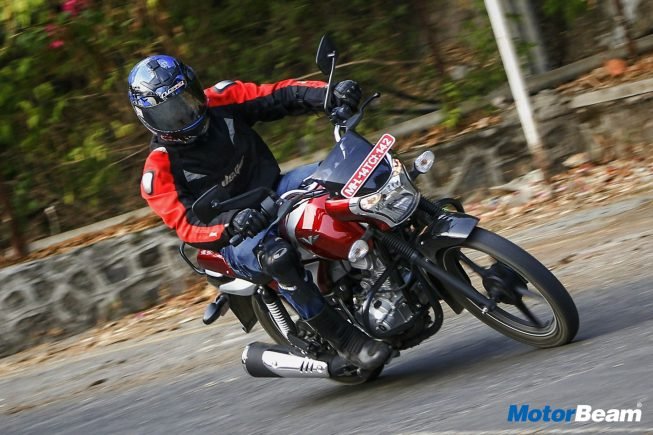Text – Viraj David; Pictures – Avdhoot Kolhe

Bajaj V12 Review
Bike Tested: Bajaj V12; Road Test No. 779
Price OTR Mumbai: Rs. 70,256/-
The Bajaj V12 is a commuter motorcycle based on the platform of the V15
Bajaj introduced a new series, the ‘Bajaj V’ by launching the V15 a few months back. Bajaj made it an iconic motorcycle by taking the metal of the decommissioned iconic Indian aircraft carrier INS Vikrant to make its fuel tank. Now, the Indian automaker has extended the V series by silently launching a commuter motorcycle again, the Bajaj V12. It was already in the pipeline since the V15’s production and it is based on the same platform as that of the V15. The Bajaj V12 also uses some metal from the INS Vikrant in its production and carries the same design as that of the V15. Being in the commuter segment, the V12 loses some premium features like front disc brake, tubeless tyres, digital/LED fuel gauge and 10-spoke alloy wheels which are seen on the V15.
Motor Quest: The Bajaj V12 is the second motorcycle to be launched in the ‘Bajaj V’ series and like the V15, it uses some metal in its construction from the decommissioned majestic-class aircraft carrier, the INS Vikrant of the Indian Navy which played a vital role during the Indo-Pak war in 1971.
In terms of styling, the V12 looks like the carbon copy of the V15
Styling – The Bajaj V12 takes its styling inspiration from its elder sibling, the V15. All the visible body parts are carried from the V15. So, the V12 looks similar to the V15 but still manages to look unique. It carries the same butterfly shaped headlamp with chrome edges with a small visor at the front and the same classic LED tail-light at the rear. The headlight gets a smaller power bulb of 12V 35/35W while the V15 gets a 12V 55/60W bulb. The muscular sculpted tank uses some metal of the INS Vikrant and gets a chrome fuel cap with an anchor’s logo and INS Vikrant initials on it. Infact, it’s the same fuel tank that is seen on the V15. The single-piece wide seat gets premium texture treatment and ofcourse there is the removable rear seat cowl on this 125cc motorcycle too which adds the café racer like looks to this motorcycle.
The bird’s beak-like rear panel remains unchanged, but the bike has all the right proportions
The iconic V badging has been given more importance and thus there is no Bajaj logo anywhere on the bike
The front mudguard comes in black color whereas on the V15, it is body-colored. At your first glance, you won’t be able to make out the difference between the both (V12 and V15), but when observed properly, you will notice that there are now 5-spoke alloy wheels (lighter in weight) instead of ten and sort of different sticker pattern on the new V12 to make it look unique and of course the badging. The V12 also loses out on a front disc brake and tubeless tyres and the rear tyre is now slimmer. Though the V12 also misses out on aluminium parts because of the cost cutting factor but the overall fit and finish of the parts is really good.
The fully analogue instrument cluster gets no trip meters
Instrument Cluster and Switchgear – The instrument cluster here is carried from the V15 but misses on the digital fuel gauge meter now and is fully analogue. The speed fonts in the speedometer are really tiny and while you are on the move, you will find it difficult to read them. But I would love it if the company would have given a part digital and a part analogue instrument cluster like its competition vehicles. The plastic quality of the switchgear is good and its fitting too is very decent. All switches are within the proper reach of the rider and are easy to use.
Seating position is upright and makes the bike a relaxed daily commuter
Ergonomics – Like the V15, the V12 also features a city commuter’s ergonomics. It has an upright seating position with a perfect combination of wide handlebars for your wide open chest feeling, front set foot pegs and a comfortable seat. The 13-litre fuel tank is sculpted well to offer ample of comfort to your legs. The single-piece seat is well cushioned and is comfortable for long rides. The rear seat hosts a removable cowl which can be removed with an allen key which comes integrated into the bike’s key like the V15. The decent grab rails are within proper reach of the pillion and feel good to hold. The V12’s saddle height of 780 mm makes it an accessible bike to both short and tall riders. Its ergonomics make it a relaxed city commuter and a user-friendly motorcycle.
The V12’s engine is well refined and smooth
Performance – What powers the new Bajaj V12 is a single-cylinder, 124.5cc, air-cooled DTS-i engine. This mill produces 10.55 BHP of power at 7500 RPM and enough torque of 10.98 Nm at 5500 RPM. The transmission duties on this bike are taken care by a 5-speed, all-up pattern gearbox. The V12 produces 1 Nm of more torque than its competition bikes and is quick off the line too. It has a torquey nature like the V15 and cruising through city traffic becomes very relaxing.
Vibes come in post 80 km/hr, isn’t that great?
The Bajaj V12 has good low-end & mid-range torque but lacks in the top-end
With no stress I clocked 90+ km/hr and the addition of the fifth gear to this bike helped me do that. There were no vibrations at all till 80 km/hr and that’s a very good news. The clutch and gear operate smoothly. The V12 has good low-end and mid-range torque which lets you cruise through the traffic even without changing gears all the time. The bike revs quickly and reacted actively to every throttle input of mine. And like the V15, the V12 also produces a throaty exhaust note.
Ride quality is softer than the V15
Riding Dynamics – The Bajaj V12 offers a commanding upright sitting posture. It is said to use the same chassis as that of the V15 but only because of the cost-cutting factor, it gets fabricated metal parts instead of aluminium. The seats are well padded and the handlebar is within proper reach. It really is a relaxed motorcycle while riding through the city and a fun to ride motorcycle on the highway. The engine is refined and smooth. Its refinement levels are higher than the V15. Well, due to the cost cutting factor again, this bike is only offered with drum brakes at both the front and rear. The front brake did lack the bite but the rear one had enough bite. The disc brake is not offered even as an option but it will be introduced in the near future, says the company. But it would have been really great if this bike was equipped with a disc brake since the time of launch.
The front drum brakes of the V12 are not very satisfactory
Good combination of ergos make this bike a comfortable commuter
The Bajaj V12 runs on 18-inch (front) and 16-inch (rear) rims. Yes, it rides on narrower 2.75 x 18 and 100/90/16 MRF Kurve tube-type tyres. The front tyre being narrower allows you to change lanes quickly. It becomes easy to make quick u-turns too. The tyres provide good amount of grip and can corner pretty well. Only hard leaning into corners is not advisable at all as the front tyre is bigger than the rear. The suspension does its job very well and keeps the ride composed and stable and it’s not stiff like the V15.
The Bajaj V12 stands out in its category
Verdict – The V15 proved out to be a great success for the company and we hope they do the same with the new V12. At Rs. 56,283/- (ex-showroom, Delhi), it has been aggressively priced. The V12 for sure is a better looking motorcycle in its segment, except for its headlamp though. The engine is smooth and refined. The ride quality is stable and good. It performs well in the city and on the highway. It is a premium commuter motorcycle and offers many things which its competition motorcycles do not offer. The V12 contains the metal of the INS Vikrant and owning this bike is like owning a piece of our heritage and riding it with all pride, that’s how many customers are likely to associate with it.
Bajaj did something what no one else could, the sign of Pride and Prestige
What’s Cool
* Torquey nature of the engine with good low-end and mid-range torque
* Comfortable ergonomics
* Well refined and vibe free engine
* Nice paintjob with stickers
* Throaty exhaust note
What’s Not So Cool
* The butterfly-shaped headlamp design does not go well with the bike
* Vibrations when revved hard, bike can only do sane riding
* Slim tyres
* Shaky mirrors
* Front drum brake
With its extraordinary looks, it stands with all dignity
Bajaj V12 Specifications
* Engine: 124.5cc, single-cylinder, 2-valve, DTS-i
* Power: 10.55 BHP @ 7500 RPM
* Torque: 10.98 Nm @ 5500 RPM
* Transmission: 5-speed, all-up pattern
* Fuel Consumption: 55 km/l
* Fuel Type: Petrol
* Frame: Double Cradle
* Suspension: 110 mm telescopic forks (Front), Twin shocks, NITROX gas filled (Rear)
* Tyres: 2.75 x 18 (Front), 100/90/16 (Rear)
* Brakes: 130 mm Drum (Front), 130 mm drum (Rear)
Bajaj V12 Dimensions
* Length x Width x Height: 2040 mm x 785 mm x 1066 mm
* Wheelbase: 1315 mm
* Ground Clearance: 165 mm
* Seat Height: 780 mm
* Fuel Tank Capacity: 13-litres (1.7-litres useable reserve)
* Kerb Weight: 133 kgs





